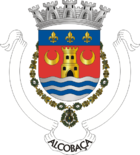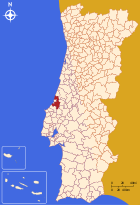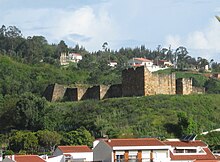Alcobaça (Portugal)
| Alcobaça | ||||||
|---|---|---|---|---|---|---|
|
||||||
| Basic data | ||||||
| Region : | Centro | |||||
| Sub-region : | Oeste | |||||
| District : | Leiria | |||||
| Concelho : | Alcobaça | |||||
| Coordinates : | 39 ° 33 ′ N , 8 ° 59 ′ W | |||||
| Residents: | 5699 (as of June 30, 2011) | |||||
| Surface: | 3.07 km² (as of January 1, 2010) | |||||
| Population density : | 1856 inhabitants per km² | |||||
| Postal code : | 246x | |||||
| politics | ||||||
| Mayor : | Maria Manuela Ferreira Duarte Pombo | |||||
| Address of the municipal administration: | Junta de Freguesia de Alcobaça Rua D. Pedro V, 37/39 2460-029 Alcobaça |
|||||
| Alcobaça district | ||||||
|
||||||
| Residents: | 56,688 (as of June 30, 2011) | |||||
| Surface: | 408.15 km² (as of January 1, 2010) | |||||
| Population density : | 139 inhabitants per km² | |||||
| Number of municipalities : | 13 | |||||
| administration | ||||||
| Administration address: | Paços do Concelho Praça João de Deus Ramos 2461-501 Alcobaça |
|||||
| President of the Câmara Municipal: | Paulo Jorge Marques Inácio ( PSD ) | |||||
| Website: | www.cm-alcobaca.pt | |||||
Alcobaça [ aɫkuˈbasɐ ] is a city in Portugal with 5699 inhabitants (as of June 30, 2011). It is located in the Oeste sub-region and belongs to the historic province of Estremadura (administratively now Região Centro ).
Although it is about 10 km away from the Atlantic, the Alcoa river only flows through the city at a height of a few meters above sea level. In the early Middle Ages , the sea extended as a lagoon from Pederneira to the gates of Alcobaça near Fervenca. The city has an area of 3.1 km². Alcobaça is the seat of the district of the same name ( Município de Alcobaça) with 56,688 inhabitants and an area of 408.2 km², which extends between the Atlantic and the up to 613 m high Serra de Candeeiros mountains . This area, together with the neighboring district of Nazaré (with 82.4 km²) and parts of the adjacent district of Caldas da Rainha to the south, corresponds to the historical donation of the first king of Portugal Afonso Henriques to the Cistercian abbot Bernhard von Clairvaux in 1153, from the the Royal Abbey of Alcobaça with the Coutos de Alcobaça as their secular dominion.
Alcobaça received the modern city charter (as Cidade ) in 1995. The old town is characterized by the monastery (Mosteiro de Alcobaça), which was included in the list of UNESCO as a world cultural heritage in 1989 , and a castle. In the years 2004–2007 it was completely redesigned to a restricted traffic zone, whereby the monastery forecourt was also redesigned according to historical templates. The National Wine Museum (1968) is on the road to Aljubarrota .
history
etymology
The origin of the name is disputed. In Roman times, the settlement probably bore the name Helcobatiae , by the conquest of the Moors in Al-cobaxa to have been changed. One opinion now derives the names of the rivers Alcoa and Baça, which meet in Alcobaça, from Al-cobaxa , while the other holds the rivers as the namesake.
Early and Roman times
Evidence of settlement in the Bronze Age can already be found in the area of Alcobaça . In Roman times the settlement was called Helcobatiae and belonged to the province of Hispania Ulterior , after the reform of the emperor Augustus to the province of Lusitania , there the sub-province of Scalabis , today's Santarém . The area of Alcobaça was crossed by a Roman road that connected the Roman cities of Colipo (São Sebatião do Freixo near Leiria ), Araducta (probably today's Alfeizerão ) and Eburobritium (near Óbidos ), among others .
Alcobaça Monastery
In Alcobaça is the Mosteiro de Alcobaça, one of the largest, most famous and oldest monasteries in the country ( World Heritage Site ). It was the seat of the Real Abadia de Alcobaça (Royal Abbey of Alcobaça), which from 1567 also headed all Portuguese Cistercian monasteries as the Autonomous Cistercian Congregation of Saint Bernard of Alcobaça . The complex goes back to the year 1153, when Portugal's first king Afonso Henriques gave the order of the Cistercians the approximately 500 km² large subsequent monastery area, which had been won from the hands of the Moors. Bernhard von Clairvaux (1090-1153), abbot of the main Cistercian monastery in Clairvaux and one of the most influential clerics of his time, had him in his disputes with Alfonso VII of Leao and Castile because of the unilaterally declared independence of Portugal and the self-coronation of Alfonso Henriques as king of Portugal in 1139 probably got the support of the Pope, especially since from 1145 to 1153 with Eugene III. for the first time a Cistercian sat on the papal throne. The papal bull for the recognition of Portugal, now from Alexander III. issued, but had to wait until 1179.
The construction of the monastery began in 1178 and ended with its first section (church and first cloister) in 1240. As a result of the strong influx of friars, especially from Burgundy, the complex was constantly expanded, including three more cloisters (two of which have been preserved in addition to the first from 1178). The library was built in 1755, at that time one of the largest in Portugal, before in 1834, after the monks had already left the monastery in the previous year, Alcobaça, like all other monasteries in Portugal, had to close due to government orders.
Alcobaça Castle
To the west and 70 meters above the monastery are the ruins of the Castelo de Alcobaça , a castle complex of Moorish, in other opinion already Wisigothic ( Visigoth ) origin. Together with the castles of Leiria , Santarem and Alfeizeirão, it had probably served the Moors as a front line between the Tejo and Mondego rivers . It was badly damaged during the Reconquista in the 12th century , so that it was rebuilt by King Afonso Henriques from 1147 and above all by his successor King Sancho I (1154–1211). In the following years it mainly served to protect the monks from the Moors invading again and again, as in 1184 and 1195, when the monastery under construction was badly destroyed. In 1422 the Castelo was badly damaged in an earthquake, but was rebuilt. The Lisbon earthquake in 1755 it was heavily damaged again. In 1838 Queen Maria II (Portugal) ordered the castle to be grinded and the county began selling the stones that were used in many civil buildings of the time. The outer walls were partially restored in 1952/53.
Churches
About 400 meters north on the other side of the Alcoa River is the church of Nossa Senhora da Conceição , which dates back to the temporary monastery, the Abadia Velha, built in 1153. A church, Igreja Nova , built directly opposite the monastery in 1648 , which served as the parish church of Alcobaça, was torn down in 1915 to make way for an intended new museum with a theater. However, this did not happen, instead the post office building with telegraph office was built there. In front of the parish church there was also a stake ( pelourinho ), the symbol of the abbey's jurisdiction, which was also demolished.
Coutos de Alcobaça
From the monastery in Alcobaça, the land donated to it was reclaimed and settled in the following centuries. Most of the other localities in the district emerged from Meierhöfe founded by the monks , of which churches and stakes ( pelourinhos , pillars of poor sinners) still bear witness today . In this way the secular dominion of the abbey, the Coutos de Alcobaça , came into being, to which besides Alcobaça another 13 cities belonged. In addition to viticulture, the monks also cultivated nuts and olives, later also fruit cultivation, for which Alcobaça is still known today, and salt pans in the inland lagoons for salt production. In Alfeizerão , today inland less than 5 km from the lagoon of São Martinho do Porto , as well as in Pederneira, today part of Nazaré , and Paredes da Vitória , the monastery already had its own ports in the Middle Ages.
administration
circle
Alcobaça is the seat of the district of the same name, the local self-government in Município de Alcobaça. The district ( concelho ) of Alcobaça belongs to the district of Leiria . On June 30, 2011 the district had 56,688 inhabitants on an area of 408.2 km². Alcobaça is also the seat of a court of first instance.
The neighboring districts are Marinha Grande to the north, Leiria , Porto de Mós , Santarém and Rio Maior to the east, Caldas da Rainha to the southeast and Alcobaça encloses Nazaré to the west and borders the Atlantic on both sides.
With the regional reform in September 2013, several municipalities were merged into new municipalities, so that the number of municipalities decreased from 19 to 13.
The following municipalities ( Freguesias ) are in this district:
| local community | Population (2011) |
Area km² |
Density of population / km² |
LAU code |
|---|---|---|---|---|
| Alcobaça e Vestiaria | 7.009 | 9.81 | 715 | 100121 |
| Alfeizerão | 3,854 | 27.99 | 138 | 100102 |
| Aljubarrota | 6,639 | 47.94 | 138 | 100120 |
| Bárrio | 1,523 | 15.01 | 101 | 100104 |
| Benedita | 8,635 | 29.18 | 296 | 100105 |
| Cela | 3,264 | 25.83 | 126 | 100106 |
| Coz, Alpedriz e Montes | 3,261 | 37.47 | 87 | 100122 |
| Évora de Alcobaça | 4,485 | 42.42 | 106 | 100108 |
| Maiorga | 2,050 | 10.04 | 204 | 100109 |
| Pataias e Martingança | 6,591 | 87.08 | 76 | 100123 |
| São Martinho do Porto | 2,868 | 14.64 | 196 | 100112 |
| Turquel | 4,561 | 40.57 | 112 | 100114 |
| Vimeiro | 1,948 | 20.17 | 97 | 100116 |
| Alcobaça district | 56,688 | 408.15 | 139 | 1001 |
Population development
| Population in the district (1801–2011) | ||||||||
|---|---|---|---|---|---|---|---|---|
| 1801 | 1849 | 1900 | 1930 | 1960 | 1981 | 1991 | 2001 | 2011 |
| 4,630 | 14,711 | 28,969 | 38,462 | 50,027 | 52,347 | 54,382 | 55,376 | 56,569 |
Municipal holiday
- 20th of August
Town twinning
economy
Alcobaça and the region are known for fruit growing and for its ceramic and glass production, which has been in decline since the end of the last century. Besides the city of Alcobaça, tourism is particularly important for the parts of the district facing the Atlantic.
Surroundings
Since the beginning of the new century, the Alcobaça district has also been nicknamed Terra da Paixão , which means the land of passion. This was probably in allusion to the love story between King Pedro I and Inês de Castro , who are both resting in sarcophagi facing each other in the transept of the abbey church of the Alcobaça monastery and waiting for their resurrection on Judgment Day to be the first to look into their eyes see. In fact, the area has been shaped by a passionate devotion to Mary for centuries . Within less than 35 km of corridor east of the Atlantic are four significant sites dedicated to Saint Mary. Only 18 km north of Alcobaça is the Mosteiro da Batalha , another important Dominican Marian monastery , which King João I named after the victorious battle of Aljubarrota in 1385, which was named after the town of the same name Aljubarrota , only 6 km from Alcobaça Thanks to St. Mary donated because Portugal was able to successfully repel Castile's grip on the Portuguese crown.
In Aljubarrota there is also a monument to a baker with a bread shovel, with which, according to legend, she is said to have killed seven Spanish soldiers.
14 km east of Batalha is the pilgrimage site of Fátima , where apparitions of the Virgin Mary are said to have taken place for half a year in 1917. Since then, millions of people have made pilgrimages to Fátima, including two Popes, Pope John Paul II even three times. The bullet that entered his abdomen in the assassination attempt on May 13, 1981, was captured in a crown that now bears the statue of the Madonna of Fátima.
10 km west of Alcobaça is the fishing port and tourist town of Nazaré , in the district of Sítio , 110 m high above the sea on a rocky promontory, the most important Portuguese pilgrimage site for centuries up to the beginning of the 20th century, O Santuário de Nossa Senhora da Nazaré (Shrine of Our Loved Ones Woman of Nazareth) is located. The church in its current form dates from the 17th century, but is based on a church from the 14th century and a chapel from the 12th / 13th. Century back. The allegedly oldest statue of the Virgin Mary in the West, A Sagrada Imagem de Nossa Senhora da Nazaré (The Sacred Image of Our Lady of Nazareth) is kept in its main altar, which is also accessible to the faithful via a stage .
sons and daughters of the town
- António Brandão (1584–1637), Cistercian monk and historian
- António Brandão (1620–1681), Archbishop of Goa
- Eugénio dos Santos (1711–1760), military engineer and architect, especially in the reconstruction after the earthquake in 1755 , including the Lisbon lower town
- Fortunato de São Boaventura (1777–1844), Archbishop of Évora
- José Eduardo Raposo de Magalhães (1844–1942), engineer
- Manuel Vieira Natividade (1860–1918), archaeologist
- Virgínia Vitorino (1895–1967), poet and playwright
- Gonçalo Byrne (* 1941), architect
- Alberto Bernardes Costa (* 1947), lawyer and socialist politician, multiple minister
- José Augusto Traquina Maria (* 1954), Roman Catholic clergyman and Bishop of Santarém
- Valdemar José Correia Barbosa Rodrigues (* 1965), environmental scientist, university professor and writer
- John Gonçalves (* 1974), musician, bassist and keyboardist in the band The Gift
- Miguel Ribeiro (* 1975), musician, guitarist and founding member of the band The Gift
- Sónia Tavares (* 1977), musician, singer in the bands The Gift and Hoje
- Bruno Pires (* 1981), racing cyclist
Bruno Pires before the prologue of the Tour de Romandie 2011
Web links
- Map of the Freguesia Alcobaça (Portugal) at the Instituto Geográfico do Exército
- Photos from ALCOBAÇA on Flickr
- Official website of the city administration (port.)
Individual evidence
- ↑ www.ine.pt - indicator resident population by place of residence and sex; Decennial in the database of the Instituto Nacional de Estatística
- ↑ a b Overview of code assignments from Freguesias on epp.eurostat.ec.europa.eu
- ↑ a b www.ine.pt - indicator resident population by place of residence and sex; Decennial in the database of the Instituto Nacional de Estatística
- ^ Publication of the administrative reorganization in the Diário da República gazette of January 28, 2013, accessed on March 16, 2014
- ↑ www.anmp.pt , accessed December 30, 2012

















